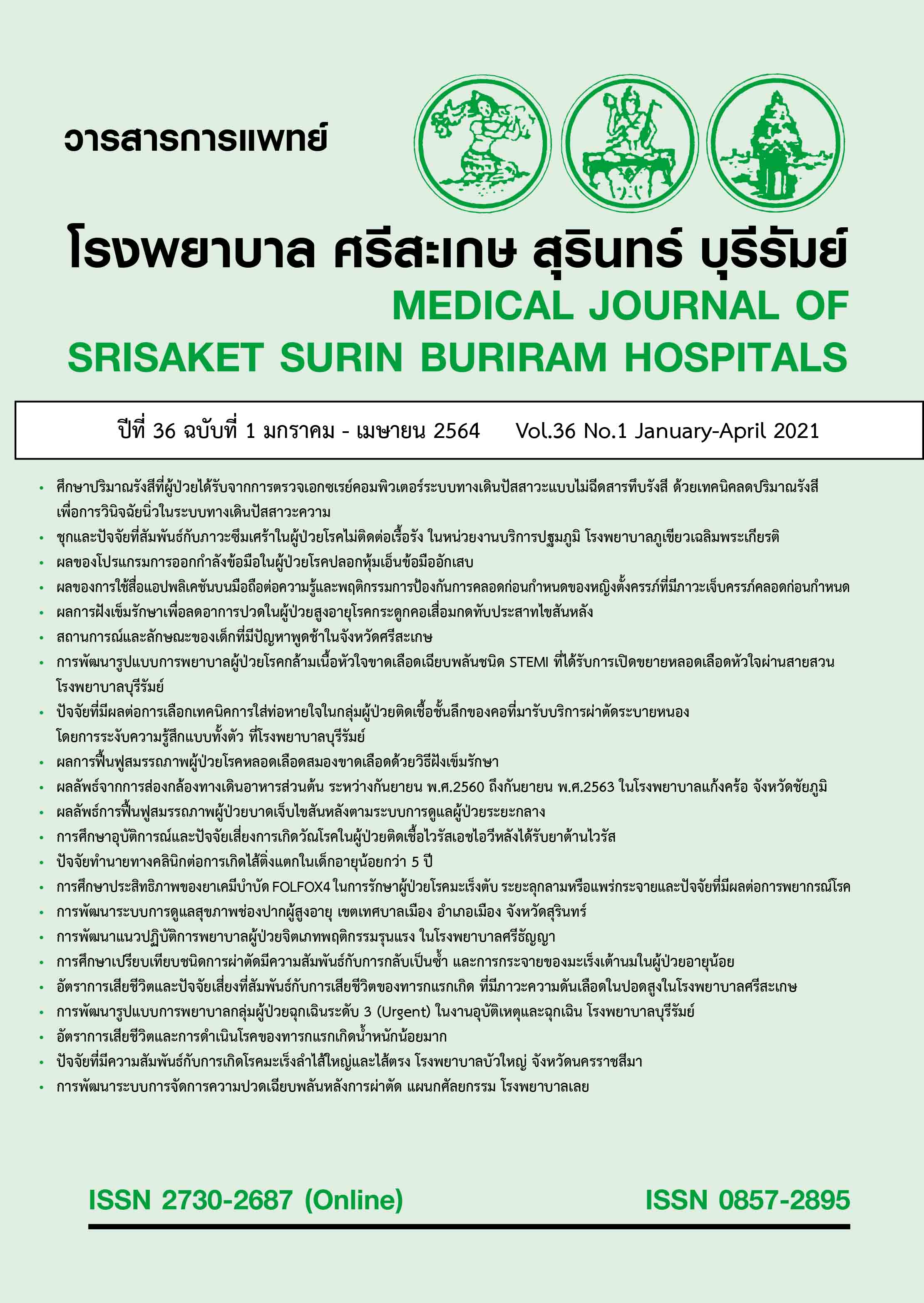ผลการฟื้นฟูสมรรถภาพผู้ป่วยโรคหลอดเลือดสมองขาดเลือดด้วยวิธีฝังเข็มรักษา
Main Article Content
บทคัดย่อ
หลักการและเหตุผล: การฟื้นฟูสมรรถภาพในผู้ป่วยโรคหลอดเลือดสมองหลังจากพ้นระยะวิกฤตแล้วด้วยการฝังเข็มรักษาเป็นแพทย์ทางเลือก และAdjuvant therapyช่วยเพิ่มการไหลเวียนของเลือดไปเลี้ยงและ เพิ่มการทำงานของเอนไซม์ต้านอนุมูลอิสระ
วัตถุประสงค์: เพื่อศึกษาระยะเวลามัธยฐานในการฟื้นฟูสมรรถภาพ และปัจจัยทำนายที่มีความสัมพันธ์ต่อการฟื้นฟูสมรรถภาพผู้ป่วยโรคหลอดเลือดสมองขาดเลือด ด้วยวิธีฝังเข็มรักษา กลุ่มงานแพทย์แผนไทยและแพทย์ทางเลือก โรงพยาบาลชัยภูมิ
วิธีการศึกษา: การศึกษาเชิงวิเคราะห์ย้อนหลังในผู้ป่วยโรคหลอดเลือดสมองขาดเลือดระยะหลังเฉียบพลันที่มีอายุ 20 ปีขึ้นไป เข้ารับการรักษาด้วยวิธีการฝังเข็ม ระหว่างวันที่ 1 ตุลาคม พ.ศ. 2558 – วันที่ 30 เมษายน พ.ศ. 2563 ติดตามการรักษานาน 1 ปี หรือจนกระทั่งผู้ป่วยที่ได้รับฟื้นฟูสมรรถภาพสามารถปฏิบัติกิจวัตรประจำวันได้ หรือผู้ป่วยไม่มาตรวจตามนัดหรือเสียชีวิต
ผลการศึกษา: ผู้ป่วยโรคหลอดเลือดสมองขาดเลือด จำนวน 72 ราย กลุ่มผู้ป่วยที่มีการฟื้นฟูสภาพระดับดี (score≥75) จำนวน 50 ราย กลุ่มผู้ป่วยที่ฟื้นฟูสภาพระดับปานกลาง (score 50-70) จำนวน 22 ราย อายุเฉลี่ย 62.1±11.3 ปี เพศชาย ร้อยละ 61.1 อาการทางคลินิกที่ตรวจพบได้แก่ Left hemiparesis ร้อยละ 59.7 right hemiparesis ร้อยละ 40.3และataxia ร้อยละ 34.7 โรคร่วมที่พบได้แก่ Hypertension ร้อยละ 43.1Diabetes mellitus ร้อยละ 27.8 ได้รับการรักษาเพื่อป้องกันด้วยยา Antiplatelet ร้อยล 18.1Small vessel atherosclerosis (SAO) ร้อยละ 41.7, Cardiac embolism (CE) ร้อยละ 22.2 และ Large artery atherosclerosis (LAA) ร้อยละ 15.3 ระยะเวลาการเจ็บป่วยถึงได้รับการฝังเข็มรักษาเฉลี่ย 26.9±11.5 วัน ปัจจัยทำนายที่มีความสัมพันธ์กับผลลัพธ์การฟื้นฟูสมรรถภาพได้แก่ ระดับความพิการตาม Themodified rankin scale (AOR, 2.3 ; 95% CI, 1.1-4.9) ความสามารถของผู้ป่วย ในการใช้ชีวิตประจำวันด้วย (AOR, 1.2 ; 95% CI, 1.1-1.3) และระยะเวลาการเจ็บป่วยจนกระทั่งเข้ามารับการรักษาด้วยการฝังเข็ม (AOR, 1.0 ; 95% CI, 0.9-1.0) ระยะเวลามัธยฐานในการฟื้นตัวหลังได้รับการฝังเข็มรักษาเท่ากับ 6 เดือน เมื่อวิเคราะห์แยกออกเป็นรายชนิดพบว่า มีระยะเวลามัธยฐานในการฟื้นตัว Small vessel Atherosclerosis (SAO) เท่ากับ 3 เดือน Cardiac Embolism (CE) และ Other Determined etiology (OD) เท่ากับ 6 เดือนส่วน Large vessel Atherosclerosis (LAA) และ Other Undetermined etiology (UND) เท่ากับ 9 เดือน
สรุป: การรักษาผู้ป่วยโรคหลอดเลือดสมองขาดเลือดด้วยวิธีฝังเข็มรักษาในระยะหลังจากพ้นวิกฤตภายใน 3 เดือน ให้ผลลัพธ์ที่ดีในการรักษา ส่งผลให้ผู้ป่วยมีการฟื้นฟูสมรรถภาพ สามารถปฏิบัติกิจวัตรประจำวันได้ จึงควรนำมาใช้เป็นวิธีบำบัดเสริม เป็นการฟื้นฟูสมรรถภาพโดยใช้ร่วมกับการรักษาหลักตามมาตรฐานในผู้ป่วยโรคหลอดเลือดสมองขาดเลือด
คำสำคัญ: โรคหลอดเลือดสมองขาดเลือดระยะพ้นวิกฤตการฝังเข็มรักษา
Article Details
เอกสารอ้างอิง
World Health Organization. Global burden of stroke. Geneva : World Health Organization; 2016.
Bundhamchareon K, Teerawattananon Y, Vos T, Begg S. Burden of disease and injuries in Thailand. Nonthaburi : Ministry of Public Health; 2002.
American Stroke Association. About stroke. [Internet]. 2012. [cited 2014 June 1]. Available from :URL: www.strokeassociation.org.
สมศักดิ์ เทียมเก่า. การพัฒนาเครือข่ายโรคหลอดเลือดสมองภาคอีสาน. วารสารสมาคมโรคหลอดเลือดสมองไทย 2558;14(1):3-12.
Suwanwela NC. Stroke Epidemiology in Thailand. J Stroke 2014;16(1):1-7. doi: 10.5853/jos.2014.16.1.1.
Lisabeth LD, Brown DL, Hughes R, Majersik JJ, Morgenstern LB. Acute stroke symptoms: comparing women and men. Stroke 2009;40(6):2031-6. doi: 10.1161/STROKEAHA.109.546812.
Mead GE, Hsieh CF, Lee R, Kutlubaev MA, Claxton A, Hankey GJ, et al. Selective serotonin reuptake inhibitors (SSRIs) for stroke recovery. Cochrane Database Syst Rev 2012;11(11):CD009286. doi: 10.1002/14651858.
Sirtori V, Corbetta D, Moja L, Gatti R. Constraint-induced movement therapy for upper extremities in stroke patients. Cochrane Database Syst Rev 2009;(4):CD004433. doi: 10.1002/14651858.
Zhang S, Wu B, Liu M, Li N, Zeng X, Liu H,et al. Acupuncture efficacy on ischemic stroke recovery: multicenter randomized controlled trial in China. Stroke 2015;46(5):1301-6. doi:10.1161/STROKEAHA.114.007659.
Cherubini A, Polidori MC, Bregnocchi M, Pezzuto S, Cecchetti R, Ingegni T, et al. Antioxidant profile and early outcome in stroke patients. Stroke 2000;31(10):2295-300. doi: 10.1161/01.str.31.10.2295.
Nimse SB, Pal D. Free radicals, natural antioxidants, and their reaction mechanisms. RSC Adv 2015;5:27986-28006. DOI: 10.1039/C4RA13315C
Li H, Horke S, Förstermann U. Oxidative stress in vascular disease and its pharmacological prevention. Trends Pharmacol Sci 2013;34(6):313-9. doi: 10.1016/j.tips.2013.03.007.
Johansson K, Lindgren I, Widner H, Wiklund I, Johansson BB. Can sensory stimulation improve the functional outcome in stroke patients?. Neurology 1993;43(11):2189-92. doi: 10.1212/wnl.43.11.2189.
กลุ่มงานแพทย์ทางเลือกและแพทย์แผนไทย โรงพยาบาลชัยภูมิ. สถิติผู้ใช้บริการ ปี 2558-2562. ชัยภูมิ : โรงพยาบาลชัยภูมิ: 2562.
Hu HH, Chung C, Liu TJ, Chen RC, Chen CH, Chou P, et al. A randomized controlled trial on the treatment for acute partial ischemic stroke with acupuncture. Neuroepidemiology 1993;12(2):106-13. doi: 10.1159/000110308.
Kjendahl A, Sällström S, Osten PE, Stanghelle JK, Borchgrevink CF. A one year follow-up study on the effects of acupuncture in the treatment of stroke patients in the subacute stage: a randomized, controlled study. Clin Rehabil 1997;11(3):192-200. doi: 10.1177/026921559701100302.
Sällström S, Kjendahl A, Osten PE, Stanghelle JK, Borchgrevink CF. [Acupuncture therapy in stroke during the subacute phase. A randomized controlled trial]. [Article in Norwegian]. Tidsskr Nor Laegeforen 1995;115(23):2884-7. PMID: 7570509
Christensen B. NIH stroke scale [Internet]. 2014 [cited 2016 Dec 1]. Available from:URL: http://emedicine. medscape.com/article/2172609-overview.
Shah S, Vanclay F, Cooper B. Improving the sensitivity of the Barthel Index for stroke rehabilitation. J Clin Epidemiol 1989;42(8):703-9. doi: 10.1016/0895-4356(89)90065-6.
Bonita R, Beaglehole R. Recovery of motor function after stroke. Stroke 1988;19(12):1497-500. doi: 10.1161/01.str.19.12.1497.
Chung JW, Park SH, Kim N, Kim WJ, Park JH, Ko Y, et al. Trial of ORG 10172 in Acute Stroke Treatment (TOAST) classification and vascular territory of ischemic stroke lesions diagnosed by diffusion-weighted imaging. J Am Heart Assoc 2014;3(4):e001119. doi: 10.1161/JAHA.114.001119.
Alexander DN, Cen S, Sullivan KJ, Bhavnani G, Ma X, Azen SP, et al. Effects of acupuncture treatment on poststroke motor recovery and physical function: a pilot study. Neurorehabil Neural Repair 2004;18(4):259-67. doi: 10.1177/1545968304271568.
พิชัย โรจนพิทยากร. ปัจจัยที่มีผลต่อการรักษาและระยะเวลาในการฟื้นตัวของโรคหลอดเลือดดำและหลอดเลือดแดงในสมองอุดตันในโรงพยาบาลสุราษฎร์ธานี. วารสารสมาคมโรคหลอดเลือดสมองไทย 2562;18(2)5-14.
Peters SA, Huxley RR, Woodward M. Smoking as a risk factor for stroke in women compared with men: a systematic review and meta-analysis of 81 cohorts, including 3,980,359 individuals and 42,401 strokes. Stroke 2013;44(10):2821-8. doi: 10.1161/STROKEAHA.113.002342.
Kim J, Gall SL, Dewey HM, Macdonell RA, Sturm JW, Thrift AG. Baseline smoking status and the long-term risk of death or nonfatal vascular event in people with stroke: a 10-year survival analysis. Stroke 2012;43(12):3173-8. doi: 10.1161/STROKEAHA.112.668905.
Djoussé L, Ellison RC, Beiser A, Scaramucci A, D'Agostino RB, Wolf PA. Alcohol consumption and risk of ischemic stroke: The Framingham Study. Stroke 2002;33(4):907-12. doi: 10.1161/hs0402.105245.
Mostofsky E, Burger MR, Schlaug G, Mukamal KJ, Rosamond WD, Mittleman MA. Alcohol and acute ischemic stroke onset: the stroke onset study. Stroke 2010;41(9):1845-9. doi: 10.1161/STROKEAHA.110.580092.
Songkhla Na K, Tantirittisak T, Hanchaiphiboolkul S, Wattanasen Y. Relationship between the ischemic stroke subtypes and risk factors included clinical outcome from Prasat Neurological Institute stroke registry. J Thai Stroke Soc 2014;13(1-2):3-12.
Chinwatanakul S, Boonyapisit K, Pornsriniyom D, Proyoonwiwat N, Senanarong V, Chaisevikul R, et al. Siriraj Acute Stroke Unit: 10 years experience. J Med Assoc Thai 2012;95(Suppl2):S235-44.
Kolominsky-Rabas PL, Weber M, Gefeller O, Neundoerfer B, Heuschmann PU. Epidemiology of ischemic stroke subtypes according to TOAST criteria: incidence, recurrence, and long-term survival in ischemic stroke subtypes: a population-based study. Stroke 2001;32(12):2735-40. doi: 10.1161/hs1201.100209.


